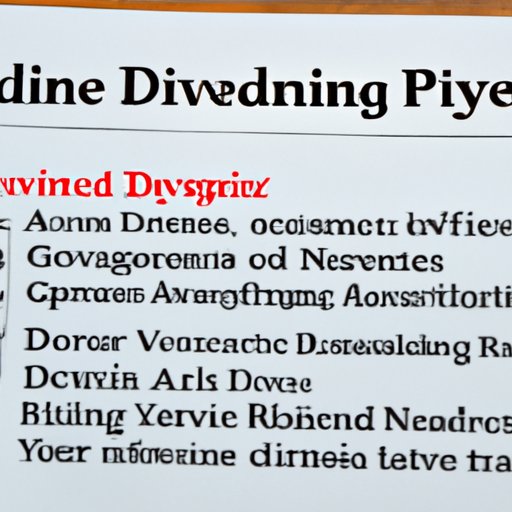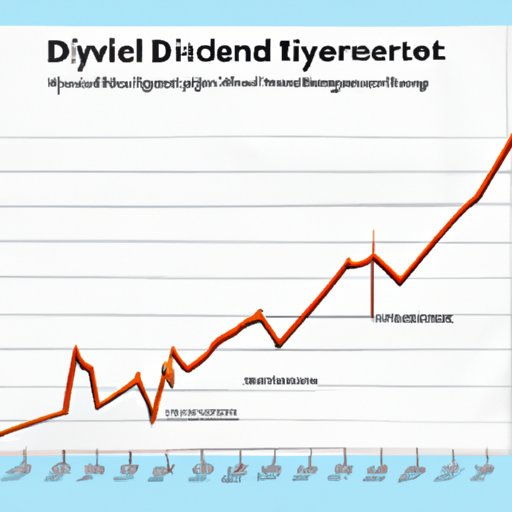Introduction
Dividend investing is a popular strategy for generating income and building wealth. It involves investing in companies that pay out regular dividends to their shareholders. By reinvesting these dividends, investors can build up a portfolio of dividend-paying stocks and enjoy a steady stream of passive income. But is it really worth it?
To answer this question, it’s important to understand the pros and cons of dividend investing. In this article, we’ll take a closer look at the potential benefits and risks, as well as the tax implications and potential returns.

Analyzing the Pros and Cons of Dividend Investing
When it comes to dividend investing, there are both advantages and disadvantages. Let’s take a closer look at both sides of the equation.
Pros:
The primary benefit of dividend investing is the reliable income it provides. Dividend payments are typically paid out on a quarterly basis, allowing you to count on a steady stream of cash flow. Additionally, since most dividend-paying stocks tend to outperform non-dividend-paying stocks over time, you also have the potential for capital growth.
From a tax perspective, dividend investing can also be beneficial. Depending on your tax bracket, some or all of your dividend payments may qualify for preferential tax treatment. This means that you could end up paying less in taxes overall.
Cons:
Of course, there are some drawbacks to dividend investing as well. The primary risk is stock market volatility. Since dividend-paying stocks are subject to the same market forces as any other type of stock, they can be just as vulnerable to sudden drops in value. This means that you could potentially lose money if the stock price falls.
Another potential downside is reduced liquidity. Since dividend-paying stocks tend to have lower turnover rates than other types of stocks, it can be more difficult to buy and sell them quickly. Finally, since the majority of dividend-paying stocks are large-cap stocks, dividend investing can limit your diversification options.

Exploring the Benefits of Dividend Investing for Retirement Planning
For those looking to maximize their retirement savings, dividend investing can be an attractive option. One of the main benefits of dividend reinvestment is the compounding effect. When you reinvest your dividends, you are essentially buying more shares of the company, which can lead to greater returns over time.
Dividend-paying stocks can also provide a cushion against inflation. As prices rise, the value of your investments can remain relatively stable thanks to the steady income generated by dividends. This makes them a great addition to any retirement portfolio.
Examining the Tax Implications of Dividend Investing
It’s important to remember that dividends are subject to taxation. How much you pay depends on the type of dividend you receive and your individual tax situation. Generally speaking, qualified dividends (which are paid out by U.S. corporations) are taxed at a lower rate than non-qualified dividends.
Fortunately, there are several strategies you can use to reduce your tax burden. For example, you can use qualified dividend income to offset capital gains from other investments, or you could invest in municipal bonds, which offer tax-free income.

Investigating the Risk Factors of Dividend Investing
In addition to the risk of stock market volatility, dividend investing carries several other risks as well. These include market risk, interest rate risk, and credit risk. Market risk refers to the possibility that the value of your investments will decline due to economic conditions, while interest rate risk refers to the chance that rising interest rates will cause stock prices to fall. Credit risk refers to the risk that a company may not be able to make its dividend payments.
Evaluating the Potential Returns from Dividend Investing
So what kind of returns can you expect from dividend investing? To get a better idea, let’s take a look at the historical performance of dividend-paying stocks. According to research from Fidelity Investments, dividend-paying stocks have outperformed non-dividend-paying stocks by an average of 2.5% per year over the past two decades.
Of course, past performance is no guarantee of future results. That said, you can still get an estimate of your expected returns by using the Capital Asset Pricing Model (CAPM). This model takes into account the expected return of the stock market, the risk-free rate, and the beta of the stock in question to calculate an estimated return.
Conclusion
In conclusion, dividend investing can be an effective way to generate income and build wealth. However, it’s important to understand the associated risks, as well as the potential tax implications. By carefully evaluating the pros and cons, you can decide if dividend investing is right for you.
By taking the time to understand the benefits and risks of dividend investing, you can make an informed decision about whether it’s worth pursuing. With the right strategy, dividend investing can be a powerful tool for retirement planning and long-term wealth building.
(Note: Is this article not meeting your expectations? Do you have knowledge or insights to share? Unlock new opportunities and expand your reach by joining our authors team. Click Registration to join us and share your expertise with our readers.)
